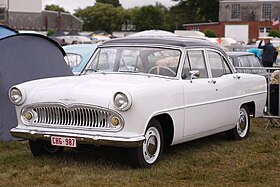Simca Ariane
| Simca Ariane | |
|---|---|
 |
|
| Overview | |
| Manufacturer | Simca |
| Production | 1957–1963 |
| Body and chassis | |
| Class | Large family car |
| Body style | 4-door saloon |
| Layout | FR layout |
| Related |
Ford Vedette Simca Vedette Simca / Chrysler Esplanada |
| Powertrain | |
| Engine | 1.3 L Flash I4 (1957 - 1963) 2.4 L Aquillon V8 (1958 - 1961) |
| Transmission | 4-speed manual. Synchromesh on top 3 ratios |
| Dimensions | |
| Wheelbase | 2,690 mm (105.9 in) |
| Length | 4,500 mm (177.2 in) |
| Width | 1,750 mm (68.9 in) |
| Height | 1,480 mm (58.3 in) |
The Simca Ariane was a large saloon car launched in April 1957 by the French automaker Simca. It was manufactured in the company's factory at Poissy until 1963.
The plant at Poissy had been built by Ford France between 1937 and 1940, but after the war the economic direction of France was uncertain. Ford had equipped the plant to produce the V8 engined Ford Vedette but the government was imposing punitive levels of car tax on cars with large engines and sales fell well short of expectations. In addition, the Poissy plant experienced above average levels of industrial unrest. Simca purchased the plant from Ford in 1954, together with rights to build the latest version of the car produced in it, which now became the Simca Vedette, relaunched by Simca with different model names according to equipment levels.
The Simca Vedette competed in France's large car market at a time when the economy was finally returning to growth, and enjoyed moderate success with their fashionably American style finished off by an Italian designer called Rapi. In 1954 the big Simcas competed in France against the Citroën Traction which was still popular despite its twenty-year-old design and the Renault Frégate which struggled to find buyers thanks to a poor mechanical reputation and, it was suggested, from the reluctance of France's haute-bourgeoisie to buy a big expensive car from a state owned enterprise.
The Suez Crisis of October 1956 was a catalyst that undermined the position of the V8 Simcas, however, due to the fuel shortages and price increases that it triggered. By this time domestic competition was in any case much intensified by the arrival of the Citroen DS which, despite getting off to a slow start, and despite being stuck with an engine design that had changed little since the 1930s, now became increasingly dominant in France's market for large family cars.
...
Wikipedia
